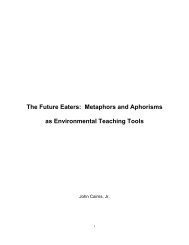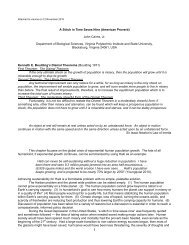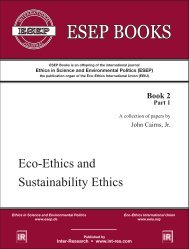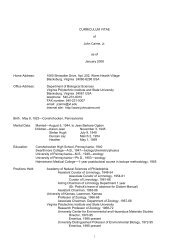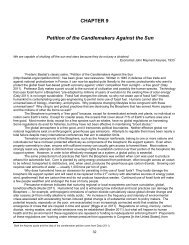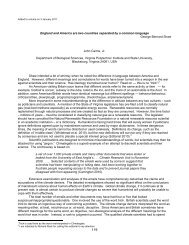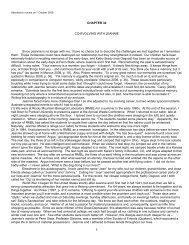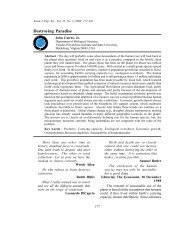View - ResearchGate
View - ResearchGate
View - ResearchGate
Create successful ePaper yourself
Turn your PDF publications into a flip-book with our unique Google optimized e-Paper software.
Article 33279These questions and many other ‘what ifs’ (e.g. pandemic disease outbreaks, global resourcewars, major reduction of food supplies due to climate change) could indicate that no nation currentlyhas enough sustainable practices to qualify as a model for the rest of the world. What, then,are the attributes of a nation that could serve as a model for achieving sustainability? A few illustrativecharacteristics follow.1. The population must stabilize at or below carrying capacity.2. Unsustainable practices must be replaced with sustainable practices at a rate of at least 5%per year.3. The citizens and leaders must be both environmentally literate and committed to a well understoodset of sustainability ethics.4. Resources must be directed toward developing and implementing sustainable practicesrather than toward war and/or preparation for war (i.e. ‘defense’).5. The ecological footprint size should not be more than 20% above the global norm.6. The use of fossil fuel should be heavily taxed; the proceeds should be used to repair ecologicaldamage.7. Purely industrial systems should be replaced by hybrid industrial/ecological systems on orbefore 2050.8. At least 25% of the land mass must be allocated to the accumulation and protection of naturalcapital and the ecosystem services it provides; the area must be capable of supporting thebiodiversity of the region.9. Dependence on the natural capital and ecosystem services of other ecoregions must beavoided.10. Neither the global commons (i.e. oceans and atmosphere) may be over-harvested or polluted;nations that exceed limits should suffer the consequences, including sanctions of othernations.11. The practice of solving overpopulation problems by exporting people to other countries mustbe abandoned.12. At least 25% of the natural systems must be self-regulating.13. Ecosystems that are deliberately or accidentally damaged (e.g. oil spills) must be immediatelyrepaired.14. Ecosystem health and integrity must be monitored in a systematic and orderly fashion.15. Persistent toxic or radioactive wastes requiring storage because they cannot be safely introducedinto natural systems are banned.16. Biodiversity is respected and maintained.17. All human artifacts (including manufactured items) and waste products are designed so they canbe recycled in both the technological and natural systems.18. The well being of future generations of the human species and other life forms have a majorinfluence on behavior.19. The ultimate criterion for sustainable use of the planet is the preservation and accumulation ofnatural capital and the ecosystem services it provides.20. If normal cyclic climatic or other episodic events increase stress on the planet’s ecological lifesupport system, human society will alter its practices so as to reduce stress on natural systemsto the degree necessary to protect their integrity.It is probable that no country would qualify as a robust model of sustainable practices. Some evidence(Wackernagel & Rees 1996) suggests that Kerala State (in India) might be a satisfactory



